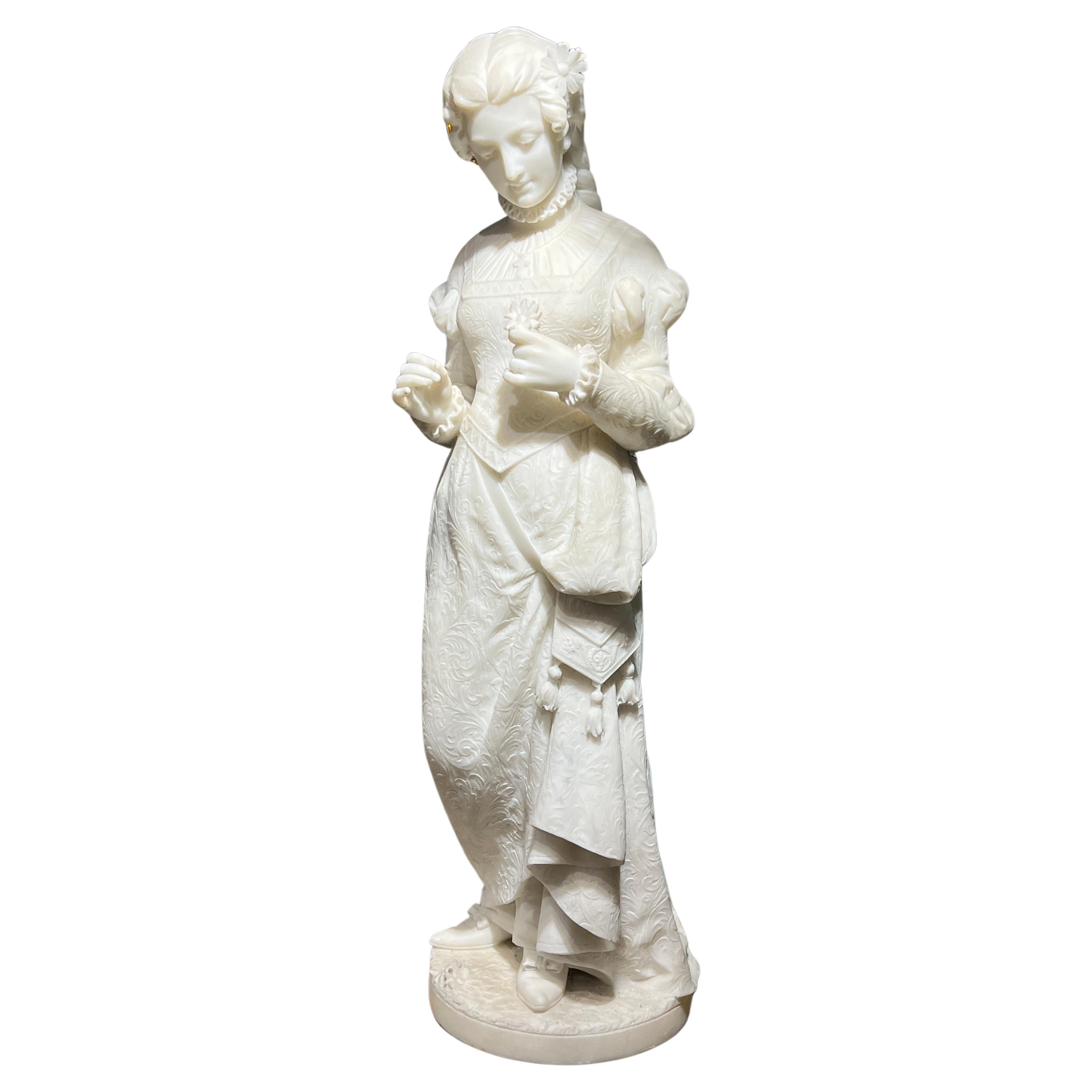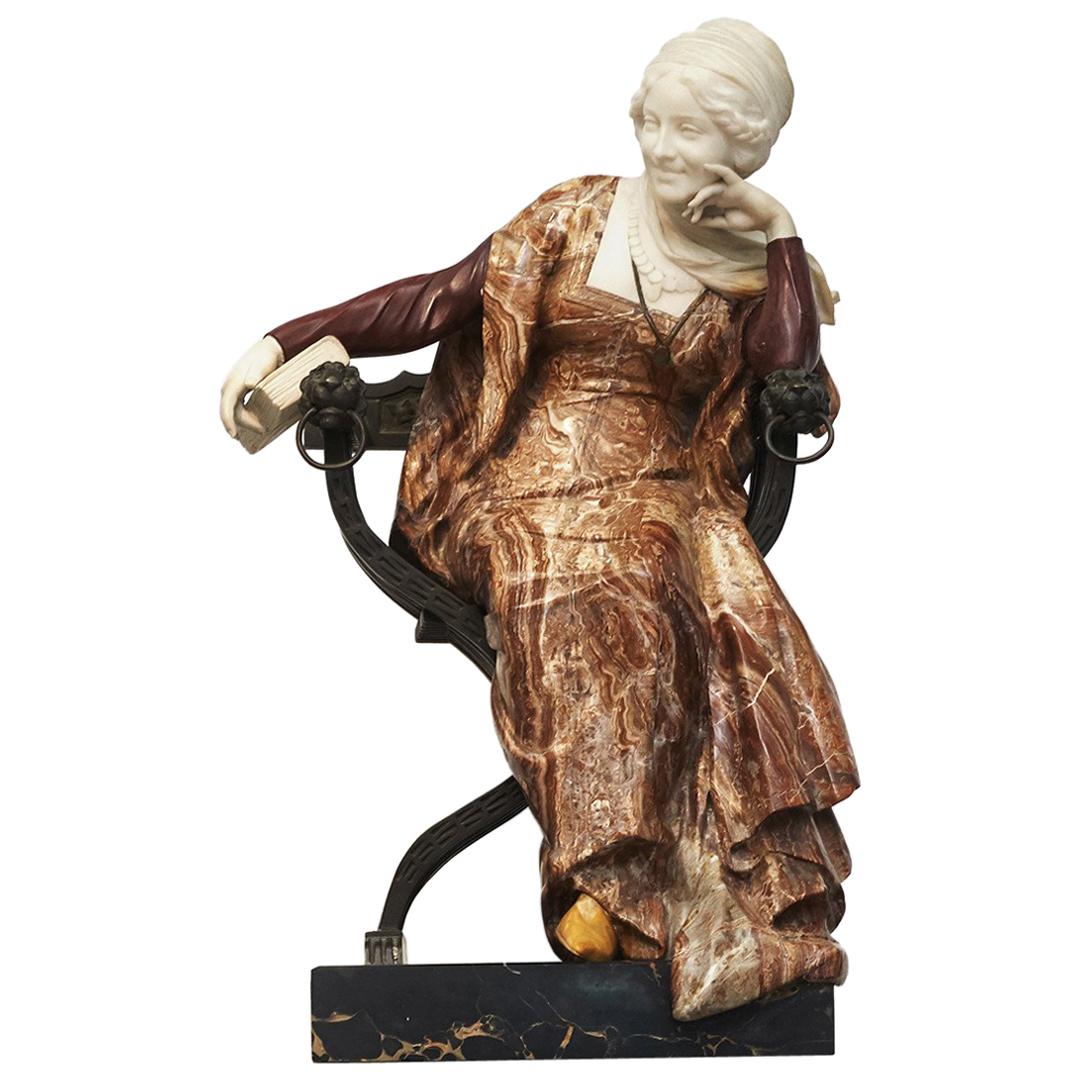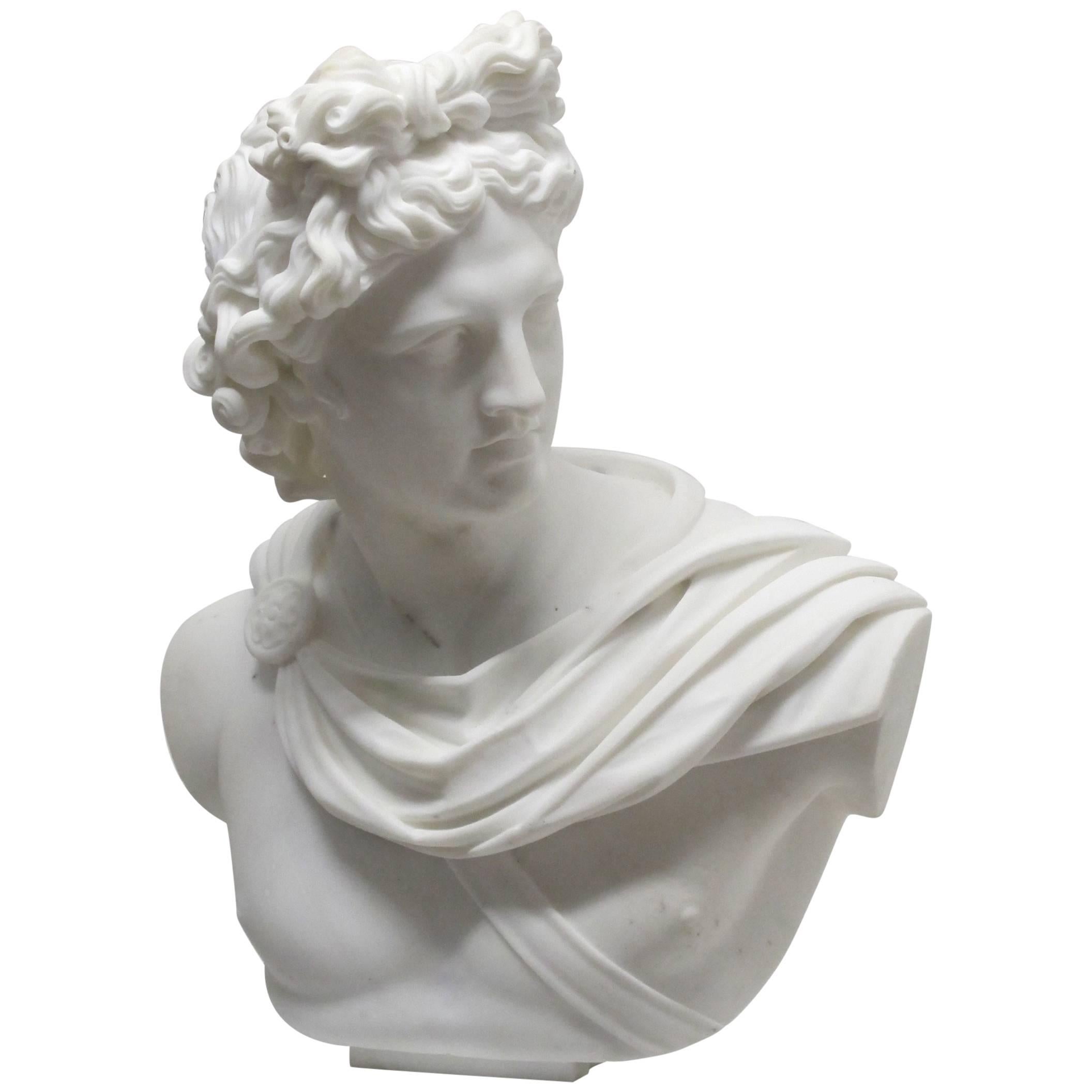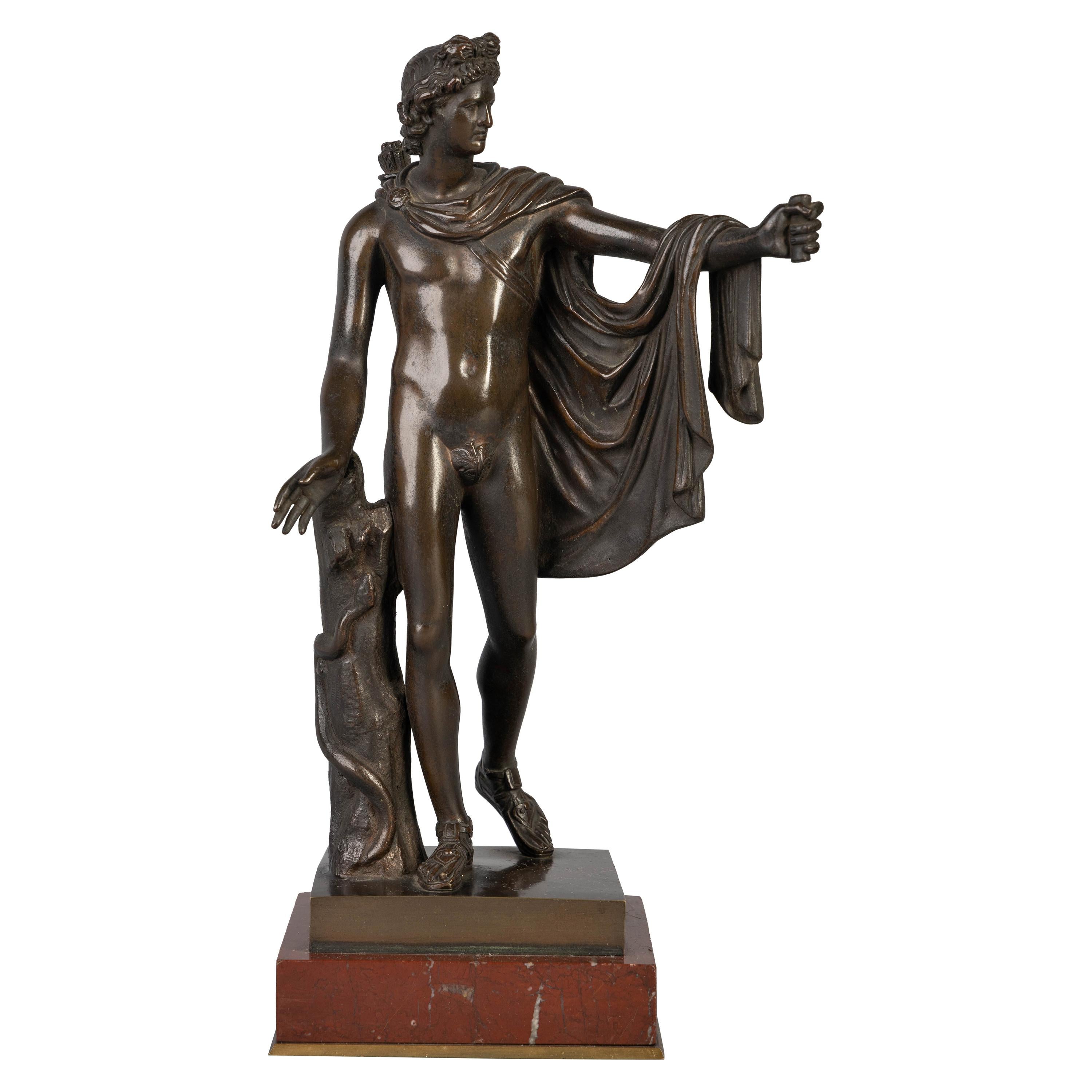Items Similar to Ferdinando Vichi Lifesize Marble Figure "Apollo Belvedere"
Want more images or videos?
Request additional images or videos from the seller
1 of 12
Ferdinando Vichi Lifesize Marble Figure "Apollo Belvedere"
About the Item
Ferdinando Vichi (Italian, 1875-1945) A fine and lifesize Italian white Carrara marble Greco-Roman figure of the Belvedere Apollo, after the original, now in the Vatican Museum, the Belvedere Apollo has defined the Greek aesthetic ideals of harmony, noble simplicity and quiet grandeur. Apollo is depicted as an archer, having just killed the Python of Delphi. The carved figure displays the tension lingering as if the arrow has just left his bow. Standing on an oval base inscribed: F. Vichi, Firenze, Made in Italy. Florence, circa 1895-1900.
Measures: Height 68 inches (192 cm)
Width 47 1/4 inches (120 cm)
Depth 38 1/2 inches (97.8 cm)
Width of base 25 inches (63.5 cm)
Former Property of Adolph Henrich Joseph Sutro's famous Cliff House and indoor public swimming establishment, The Sutro Baths - San Francisco, California.
Sutro was born in Prussia on April 29, 1830. He made a fortune building tunnels during the California Gold rush. He then moved to San Francisco and increased his wealth by turning to Real Estate. His investments included such iconic San Francisco places as Land's end (which include Lincoln Park and the current Cliff House) and of course the Sutro Baths. Although he served as San Francisco's 24th Mayor he is perhaps best remembered for the landmarks that bear his name.
Sutro also had a passion for collecting. His library which was destroyed in the 1906 fire was said to be the largest private library in the world. His compulsion for collecting reflected a keen intellect with eclectic tastes.
In 1896 he built a new house – a seven story Victorian which became known as "the Gingerbread Palace" below his estate on the bluffs of Sutro Heights. Here his collector's eye returned to the Classical and he lined the bluffs around his house with an array of Mythological and Iconic statues creating the effect of a Greek temple. In keeping with his populist view Sutro opened his home and the grounds to the public on Sunday. Vistors included local working families, the cities social elite as well as three US Presidents.
Sutro died in 1898. In the thirties, the Whitney family took possession of the Cliff House and in the 70's when they closed Playland and Sutro Baths they decided to offer the public an opportunity to own a bit of San Francisco history from these memorable sites as well as what was left from the original collection acquired by Adolph Sutro.
The sale began on January 22, 1971 at the Cliff House and lasted eleven days. According to an article in the San Francisco Examiner dated Jan 15, 1971 "Egyptian mummies, an Alaskan kayak, bathing suits used at the 1900 Sutro natatorium, marble statues..." were on sale. Those lucky enough to participate were indeed able to preserve a piece of history as evidenced in the offered lots.
The Apollo Belvedere
The Apollo Belvedere or Apollo of the Belvedere also called the Pythian Apollo is a celebrated marble sculpture from Classical Antiquity. It was rediscovered in central Italy in the late 15th century, during the Renaissance. From the mid-18th century, it was considered the greatest ancient sculpture by ardent neoclassicists and for centuries epitomized ideals of aesthetic perfection for Europeans and westernized parts of the world.
The Greek god Apollo having shot a death-dealing arrow, the episode represented may have been the slaying of Python, the primordial serpent guarding Delphi making the sculpture a Pythian Apollo; alternatively it may represent the slaying of the giant Tityos, who threatened his mother Leto, or the episode of the Niobids.
The Apollo is thought to be a Roman copy of Hadrianic date (ca. 120-140) of a lost bronze original made between 350 and 325 BC by the Greek sculptor Leochares.
Renaissance
Before its installation in the Cortile del Belvedere, the Apollo which seems to have been discovered in 1489 at Anzio, or perhaps at Grottaferrata where Giuliano della Rovere was abbot in commendam apparently received very little notice from artists. It was, however, sketched twice during the last decade of the 15th century in the book of drawings by a pupil of Domenico Ghirlandaio, now at the Escorial. Though it has always been known to have belonged to Giuliano Della Rovere before he became pope, as Julius II, its placement has been confused until as recently as 1986: Cardinal Della Rovere, who held the titulus of San Pietro in Vincoli, stayed away from Rome for the decade during Alexander VI's papacy (1494-1503); in the interim, the Apollo stood in his garden at SS. Apostoli, Deborah Brown has shown, and not at his titular church, as had been assumed.
Once it was installed in the Cortile, however, it immediately became renowned and a demand for copies of it arose. The Mantuan sculptor Pier Jacopo Alari Bonacolsi, called "L'Antico", made a careful wax model of it, which he cast in bronze, finely finished and partly gilded, to figure in the Gonzaga collection, and in further copies in a handful of others. Albrecht Dürer reversed the Apollo's pose for his Adam in a 1504 engraving of Adam and Eve, suggesting that he saw it in Rome. When L'Antico and Dürer saw it, the Apollo was probably still in the personal collection of della Rovere, who, once he was pope as Julius II, transferred the prize in 1511 to the small sculpture court of the Belvedere, the palazzetto or summerhouse that was linked to the Vatican Palace by Bramante's large Cortile del Belvedere. It became the Apollo of the Cortile del Belvedere and the name has remained with it, though the sculpture has long been indoors, in the Museo Pio-Clementino at the Vatican Museums, Rome.
In addition to Dürer, the Apollo was sketched and copied by several major artists during the late Renaissance, including Michelangelo, Bandinelli, and Goltzius. In the 1530s it was engraved by Marcantonio Raimondi, whose printed image transmitted the famous pose throughout Europe.
18th and 19th centuries
The Apollo became one of the world's most celebrated art works when in 1755 it was championed by the German art historian and archaeologist Johann Joachim Winckelmann (1717-1768) as the best example of the perfection of the Greek aesthetic ideal. Its "noble simplicity and quiet grandeur", as he described it, became one of the leading lights of neo-classicism and an icon of the Enlightenment. Goethe, Schiller and Byron all endorsed it. The Apollo was one of the artworks brought back to Paris by Napoleon after his 1796 Italian Campaign. From 1798 it formed part of the collection of the Louvre during the First Empire. After the fall of Napoleon (1815), it was repatriated to the Vatican where it has remained ever since.
The neoclassical sculptor Antonio Canova adopted the fluency of the Apollo Belvedere for his marble Perseus (Vatican Museums) in 1801. The Romantic movement, however, was not so kind to the Apollo's critical reputation. William Hazlitt (1778-1830), one of the great critics of the English language, was not impressed and dismissed it as "positively bad". The eminent art critic John Ruskin (1819-1900) wrote of his disappointment with it. Finally, starting something of a trend among later commentators, the art critic Walter Pater (1839-1894) adverted to the work's homoerotic appeal by way of explaining why it had been so long lionized. Nevertheless, the work retained much popular appeal and casts of the it were abundant in European and American public places (especially schools) throughout the 19th century.
About the artist:
Ferdinando Vichi was a central figure in the production of Florentine sculpture at the end of the 19th century. He is associated with the sculptors Cesare Lapini, Pietro Bazzanti and Guglielmo Pugi, all of whom executed works at The Galleria Bazzanti. The gallery, originally Bazzanti's studio, was inaugurated in 1822 and is still open today. His compositions are varied in subject matter, ranging from busts after the Antique to orientalist themes and Renaissance-inspired models. Like many other late nineteenth-century sculptors, Vichi often took inspiration from classical antiquity. The English inscription "Made in Italy" suggests the present sculpture was carved for export to England or America. Historicising romantic subjects were very popular in Italian sculpture of the late 19th century.
Related literature: Panzetta, vol. 1, p. 78.
- Dimensions:Height: 68 in (172.72 cm)Width: 47.25 in (120.02 cm)Depth: 38.5 in (97.79 cm)
- Style:Greco Roman (In the Style Of)
- Materials and Techniques:
- Place of Origin:
- Period:
- Date of Manufacture:circa 1895-1900
- Condition:Repaired: Some professional restoration to his right hand's fingers. Wear consistent with age and use. Minor losses. Minor fading. A truly fantastic quality life-size sculpture. Overall current condition is very good. Some professional restoration to his right hand's fingers. Minor edge chippings to the bottom base. Minor discoloration at the Apollo's foot base. See all photos.
- Seller Location:Los Angeles, CA
- Reference Number:
About the Seller
5.0
Vetted Seller
These experienced sellers undergo a comprehensive evaluation by our team of in-house experts.
Established in 1982
1stDibs seller since 2016
113 sales on 1stDibs
Typical response time: <1 hour
- ShippingRetrieving quote...Ships From: Los Angeles, CA
- Return PolicyThis item cannot be returned.
More From This SellerView All
- Lifesize Italian 19th Century Marble Figure of Cleopatra by Eliseo FattoriniBy Eliseo Tuderte Fattorini 1Located in Los Angeles, CAEliseo Tuderte Fattorini (Italian, 1830-1887). A very fine and lifesize Italian, 19th century marble figure of Cleopatra. The impressive 'qu...Category
Antique 19th Century Italian Greco Roman Figurative Sculptures
MaterialsMarble
- Over-Lifesize Patinated Bronze Greco Roman Standing Half-Figure of AndromedaLocated in Los Angeles, CAA fine over-lifesize patinated bronze Greco roman revival style standing half-figure of Andromeda, probably French, late 19th century or early 20th century. The heavily finely cast-b...Category
Antique Late 19th Century French Greco Roman Figurative Sculptures
MaterialsBronze
- Lifesize Italian 19th Century Specimen Marble Bust of a Greco-Roman WarriorLocated in Los Angeles, CAA very fine and mpressive life-size Italian, early 20th century marble bust of a Greco Roman Warrior, probably Hercules, after the antique. The large beautifully carved and decorated...Category
Early 20th Century Italian Greco Roman Busts
MaterialsMarble, Agate, Lapis Lazuli
- Lifesize French 19th-20th Century Carved Marble Sculpture of "Venus and Cupid"By Félix CharpentierLocated in Los Angeles, CAA lifesize French 19th-20th century carved marble sculpture of "Venus and Cupid" In the manner of Felix Maurice Charpentier (French, 1858-1924). The tall and slender nude figure of a...Category
Antique Early 1900s French Greco Roman Figurative Sculptures
MaterialsMarble
- Pietro Bazzanti a Carved Marble Figure Semi-Nude Young Bather GirlBy Pietro BazzantiLocated in Los Angeles, CAPietro Bazzanti - Barzanti (Italian, 1825-1895) "After the Bath" - a very Fine and large carved white Carrara marble figure of a semi-nude young maiden standing by the sea-shore. The smiling and posing young beauty, with bare breasts and back, her right arm juxtaposed over her head, while holding a blanket over her waist with her left hand and standing barefoot by a rocky seawall and wavy shoreline. Signed 'P. Barzanti/Florence' (on reverse) and raised on a cylindrical swiveling carved verde antico solid marble pedestal. circa: Florence, 1880-1890. Pietro Bazzanti or Barzanti (Italian, 1825-1895) was a 19th Century Italian sculptor born in Florence. Together with his brother, Niccolò Bazzanti (Firenze, 1802-1869) who was also a sculptor, they both worked the sprawling Florentine studio 'Pietro Bazzanti e Figlio' a hugely successful sculpture studio, operated within the family at their gallery on Lungarno Corsini until the mid-twentieth century. The studio was a place where many talented professors and apprentice sculptors specialized in sculpting marble...Category
Antique Late 19th Century Italian Greco Roman Figurative Sculptures
MaterialsMarble, Carrara Marble
- Italian 19th Century Lifesize Marble Sculpture Titled "Searching for Love"By Vito PardoLocated in Los Angeles, CAA very fine museum quality Italian 19th century lifesize marble sculpture titled "Searching for Love" by Vito Pardo (Italian, born in Venice in 1872) D...Category
Antique Early 1900s Italian Rococo Figurative Sculptures
MaterialsMarble, Bronze
You May Also Like
- Ferdinando Vichi Italian White Marble Sculpture of a FemaleBy Ferdinando VichiLocated in New York, NYMagnificent white marble statue of an elegant woman pulling petals from a flower, as in the popular 19th century game, he loves me, loves me not. by the Florentine sculpture, Ferdina...Category
Early 20th Century Italian Neoclassical Figurative Sculptures
MaterialsMarble
- Ferdinando Vichi Marble Sculpture Sitting Woman On PedestalBy Ferdinando VichiLocated in Kastrup, DK"Ferdinando Vichi", Florence 1875-1945. Romantic figure of sitting woman. Made in marble, sitting on a chair made of bronze, original pedestal of green, Italian marble. Sign. Vichi. Ca. in 1900. Ferdinando Vichi (1875-1945) was a central figure in the production of Florentine sculpture...Category
Early 20th Century Italian Renaissance Figurative Sculptures
MaterialsMarble, Bronze
- Lifesize Marble Bust of ApolloLocated in San Francisco, CAAn impressive and larger than life size hand-carved Carrara marble bust of Apollo, signed C. Scheggi (1833-1876). Showing natural inclusions in t...Category
Antique 19th Century Italian Busts
MaterialsMarble
- Early 20th Century Italian Marble Figure of an Exotic Dancer Ferdinando VichiBy Ferdinando VichiLocated in New York, NYWonderful early 20th century Italian Carrara marble figure of an exotic dancer by Ferdinando Vichi The young girl wearing a jeweled bikini, her hair flowing around her shoulders i...Category
Early 20th Century Italian Belle Époque Figurative Sculptures
MaterialsCarrara Marble
- French Bronze Figure of the Apollo BelvedereLocated in New York, NYStamped A.V., on a square red marble base.Category
Antique 19th Century French Figurative Sculptures
MaterialsBronze
- Apollo Belvedere SculptureBy Raffaello RomanelliLocated in Milan, ITThis magnificent bust of Apollo, the Greek god of art, medicine, and music is directly inspired by the Classic marble statues in the Roman tradit...Category
2010s Italian Busts
MaterialsPlaster
Recently Viewed
View AllMore Ways To Browse
Antique Bathing Suits
Dior Bathing Suit One Piece
Dior One Piece Bathing Suit
William Schiller
Lapini Marble Statue
Mummy Bronze
F Vichi
Sculpture F Vichi
Late 18th Century Bust Of Apollo
Adam Julius
Lifesize Marble Statues
Victorian Gingerbread
Antique L Marble Bust
Last Days Napoleon
1 Large Garden Statue
Goethe Bust
Italian Fire Places Marble
Bust Of Goethe





